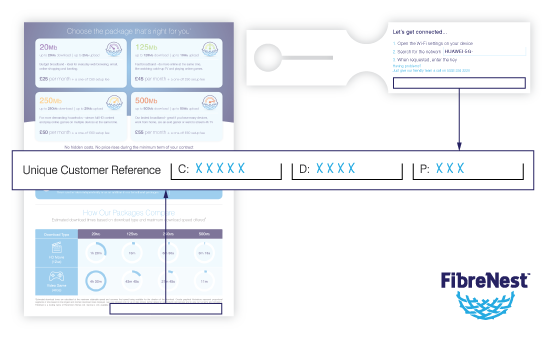
Accessibility
Conformance Statement
FibreNest recognises the importance of providing a website that can be used in a variety of ways which do not depend on a single sense, ability, or technology. Building a website which is usable, desirable and accessible for all user groups, including the disabled, and conforms with the WCAG AA 2.1 accessibility guidelines, is our ongoing commitment.
We have partnered with the Royal National Institute of Blind People to help develop our website and check it against the international standard Web Content Accessibility Guidelines 2.1 (WCAG), published by the World Wide Web Consortium (W3C).
Below there's a list of critical requirements, these have been given extra attention and highest priority during expert evaluation.
Perceivable
- Provide text alternatives for non-text content.
- Provide captions and other alternatives for multimedia.
- Create content that can be presented in different ways, including by assistive technologies, without losing meaning.
- Make it easier for users to see and hear content.
Operable
- Make all functionality available from a keyboard.
- Give users enough time to read and use content.
- Do not use content that causes seizures or physical reactions.
- Help users navigate and find content.
- Make it easier to use inputs other than keyboard.
Understandable
- Make text readable and understandable.
- Make content appear and operate in predictable ways.
- Help users avoid and correct mistakes.
Robust
- Maximise compatibility with current and future user tools.
Accessibility Features
Navigation aids
Menu links are grouped and an option to bypass navigation is provided. Link to skip navigation has no visible anchor text, and is provided specifically for people using a screen reader.
Most browsers support jumping to specific links by typing keys defined on the website. The following access keys are available throughout FibreNest site:
- S - Skip navigation
- 1 - Home page
- 2 - Broadband
- 3 - Voice
- 4 - About us
- 5 - Sign in
- 9 - Contact us
- 0 - Accessibility statement
- T - Top of the page
Wherever possible, they do not conflict with commonly-used screen reader and browser keyboard shortcuts.
Access keys are selected in different ways in different browsers:
- Internet Explorer 9+: Hold down the "ALT" key and select the number/letter of the access key, then press ENTER
- Google Chrome (Mac): Hold down the "CTRL" and "OPTION" key and select the number/letter of the access key
- Google Chrome (Windows): Hold down the "ALT" key and select the number/letter of the access key
- Mozilla Firefox (Mac): Hold down the "CTRL" and "OPTION" key and select the number/letter of the access key
- Mozilla Firefox (Windows): Hold down the "ALT" and "SHIFT" key and select the number/letter of the access key
- Microsoft Edge : Hold down the "ALT" key and select the number/letter of the access key
- Safari: Hold down the "CTRL" and "OPTION" key and select the number/letter of the access key
Semantic markup
Structured, semantic markup is used to represent document structure. H1 tags are used for main titles, h3 tags for subtitles, and so on.
Cascading style sheets are used for visual layout, and Javascript is used to enhance usability and for decorative purposes, however pages are still fully accessible if these technologies are ignored or unsupported.
Images
Descriptive and meaningful text equivalents are provided for all content images, graphical buttons, symbols and objects. Images are not used to represent text, all headings are styled with the help of CSS and can be resized to suit users needs.
Colours
Website design has been tested against colour contrast to ensure that all information is still clear. Most of the text is written as grey on white and is perfectly contrasting. Grey on white combination passes colour visibility test successfully:
- The difference in brightness between the two colours is sufficient. The threshold is 125, and the result of the foreground and background colours is 169.
- The difference in colour between the two colours is sufficient. The threshold is 500, and the result of the foreground and background colours is 501
Font sizes
Relative units have been used in markup language and CSS, therefore website layout accommodates resizing text even in Internet Explorer for Windows.


